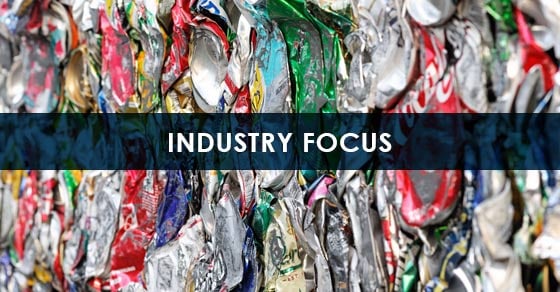Aluminum is being hailed for its prolific and growing role in the transition to a low-carbon economy; the metal is central to many of the technologies being implemented in the pursuit of a more sustainable future. As the sustainability push strengthens, secondary aluminum production is expected to play an increasing part in meeting future demand.
Here’s a look at the factors pushing the aluminum market and how aluminum recycling will gain a stronger standing in the years ahead.
Factors Pushing Aluminum Demand
Several factors are bolstering aluminum demand like never before:
Renewable Energy
Aluminum is a key material in reaching renewable energy goals, serving as an important component in all major renewable energy technologies. Usage of the metal is particularly high when it comes to solar (photovoltaic) technology.
It is no secret that renewable energy is expected to be a leading contributor to reaching global warming targets.
Increased Aluminum Beverage Can Use
Aluminum is a favored packaging material of the beverage industry – lightweight, perfect for printing on, sustainable, and excellent at preserving taste and chilling quickly. Aluminum use in the beverage industry has been on the rise as of late, particularly in the wake of the COVID-19 pandemic, which even saw a shortage of cans.
As the most sustainable type of beverage packaging, the push for increased use of the material continues to grow. The industry also boasts a high recycling adoption rate and many producers are moving away from plastic toward aluminum as a result of the rising outrage over plastic pollution.
Electric Vehicles
While aluminum has long been a viable material for use in vehicles, it has traditionally been beaten out by less-costly steel. That trend is changing, however, as car makers look to build lighter, better-performing cars, particularly when it comes to electric vehicles, or EVs.
Aluminum is about one third the weight of steel, allowing manufacturers to take advantage of the longer distances permitted by a lighter-weight battery – a key facet of widespread adoption.
Aluminum also absorbs twice the energy that steel does in a crash. It’s lighter weight provides gains in stopping distance, handling, and performance as well, according to the Aluminum Association.
New Uses in Construction
Aluminum is also seeing increased use in the construction industry. In construction, aluminum provides a sustainable building material with several benefits, including low maintenance, no curing time, and corrosion resistance, among other advantages. It is recognized for its role in developing buildings that follow LEED (Leadership in Energy and Environmental Design) standards.
China, already the world’s largest consumer of aluminum, has been investing heavily in infrastructure and construction projects during recovery from the pandemic, giving aluminum demand a boost. Further, the Chinese government has also started encouraging builders to replace wood with aluminum in frameworks for casting concrete – a result of the metal’s recyclability.
Other Growing Uses for Aluminum
In addition to these key drivers, aluminum’s many desirable qualities, paired with its sustainable nature, are seeing the metal growing in other markets as well, including aerospace, electrical wiring, electronics, appliances, and more.
The Growing Push for Aluminum Recycling
Aluminum is traditionally produced from bauxite ore. This aluminum production process is effective, but far from ideal; the process is heavily energy intensive and produces a substantial quantity of a caustic by-product known as red mud. As a result, secondary aluminum production, or the recycling of aluminum, has been experiencing a surge of interest.
Aluminum is 100% recyclable, meaning it can be recycled continuously without a loss in quality. It also results in roughly 95% energy savings and produces 95% fewer emissions compared to producing new aluminum. In short, it’s the pinnacle of sustainability and a circular economy.
Recycling aluminum would also help to conserve natural bauxite ore resources.
Conclusion
As the transition to a low-carbon economy intensifies, aluminum looks to be a critical material, with several factors, including use in renewable energy, beverage cans, electric vehicles, and even construction, calling for more of the lightweight, sustainable metal. Secondary aluminum production will also continue to gain importance in this pursuit, with its substantially lower carbon footprint.
FEECO is a preferred supplier of custom rotary dryers and decoating kilns for use in both primary and secondary aluminum production, as well as the processing of aluminum’s many derivatives and byproducts – red mud included. We also offer a unique testing facility where we can evaluate the thermal treatment and agglomeration of such materials. For more information on our custom equipment or testing services, contact us today!

